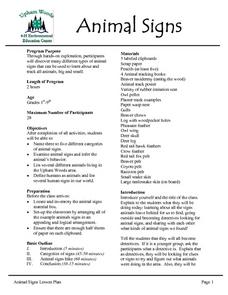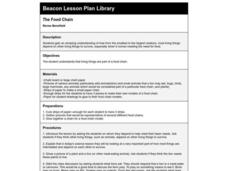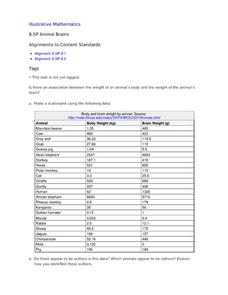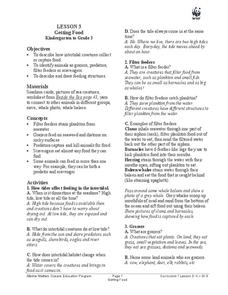Curated OER
Animals
In this animals worksheet, students guess the animals described with has got or hasn't got, complete questions, choose the correct animal, and more. Students complete 5 activities total.
Curated OER
Cranes, Crosswalks, and Big Gulps
Learners watch a video and answer questions based on wildlife jobs. In this wildlife lesson plan, students learn that biologists don't just play with animals but that there is a lot of study involved.
Curated OER
Little House in the Big Woods Chapter 2- Winter Days and Winter Nights
In this language arts worksheet, students read and learn 7 new vocabulary words and their definitions from Chapter 2 of Little House in the Big Woods. There are no questions on this page.
Curated OER
Animal Signs
Students discuss the many different types of animal signs that can be used to identify and track animals. They participate in an hands-on activity in which they examine tracks, trails, homes, territory markings, and even "scat" left by...
Curated OER
Animal Signs
Students discuss the many different types of animal signs that can be used to identify and track all types of animals. They examine tracks, trails, homes, territory markings, and even "scat" left by animals and attempt to identify the...
Curated OER
How Big Is A Humpback Whale?
Students explore humpback whales. In this humpback whale lesson plan, students determine the actual size of humpback whales and use diagrams to identify the major features of the humpback whale.
Curated OER
Animal Alphabet
Review the alphabet and the sounds each letter makes before having learners identify animals whose names begin with each letter. Working in groups of four to six, they make an animal alphabet book with the letter, a picture of the animal...
Curated OER
Activity Plan Mixed Ages: Do the Animal Dance!
Students create a dance based on animal movements. In this kinesthetic lesson plan, the students will read and imitate animals in a creative way and share their dances with the group. The instructional activity includes a take-home...
Curated OER
The Food Chain
First graders explore how most living things, big and small, need food for survival.
Curated OER
How Big is a Dinosaur?
Fourth graders create enlarged replica of a stegosaurus drawing, using a grid to practice coordinates.
ESL Kid Stuff
Describing Things (Adjectives)
Describing things using adjectives is the focus of this lesson designed for language learners. Class members play games, draw pictures, and sing songs, adding adjectives to describe animals.
Curated OER
Animal Brains
Do big bodies make big brains? Let your learners decide whether there is an association between body weight and brain weight by putting the data from different animals into a scatterplot. They can remove any outliers and then make a line...
Curated OER
Language Acquisition
Detailing the stages of language, sound, word, and grammar acquisition for babies, this presentation is a great addition to a lecture that focuses on how the English language is developed in small children. Additionally, the slideshow...
California Academy of Science
Snakes and Lizards Length and Movement
Snakes and lizards can be very tiny or very long. Your class will get out their rulers to see just how big snakes and lizards can be. They discuss several different reptiles by reading the included animal fact cards, then each small...
BBC
EU, UN, and Commonwealth
Find out how international government organizations work to face global issues. Learners examine if major organizations like the EU, UN, and Commonwealth are effective at tackling big issues like animal protection. They think about...
Curated OER
Sponge-Painted Ocean Mural
I love big mural projects. They bring a sense of ownership to the classroom, look great for parents, and can be a great way to complete a unit. Here are the steps and suggestions needed to create an ocean mural for your class. Learners...
Curated OER
Geography Experience: Low Vision
The world is a big and beautiful place; but how do you begin to understand it when you have low vision? Here is a great set of ideas focused on transforming any small room into a sensory paradise, themed to incite understanding about...
Howard Hughes Medical Institute
Modeling Trophic Cascades
In the ecological game of who eats who, one small change can have a big impact! Individuals create food chains in an array of ecosystems, then determine what happens to organisms in the chain when one organism changes its feeding...
Curated OER
Creating a Shelter
First graders create a small usable shelter for a small animal or an insect. In this shelter lesson plan, 1st graders use popsicle sticks, tree twigs, bottles, and more to build a shelter in groups.
Curated OER
Can
In this "can" worksheet, students memorize the meaning of words, answer multiple choice questions, click what animals can do, and more. Students complete 5 activities total.
Curated OER
Compare: Big/Small or Tall/Short
In this comparisons worksheet, students determine which pictures of animals are bigger/smaller or taller/shorter. A website reference for additional activities is given.
Curated OER
Should We Hunt the Largest Animals on the Planet?
Students discover details about whaling. In this environmental stewardship lesson, students research selected websites to locate information about commercial whaling and its implications.
Curated OER
Getting Food
Students complete activities to learn about the ocean food web. In this ocean life lesson plan, students discuss how the tides affect feeding, learn about filter feeders, grazers, predators, and scavengers. Students then group the...
Curated OER
Getting Food
Students explore seashore ecosystems. In this marine animal biology activity, students sort photographs of various sea creatures according to their eating habits and discuss each animal's identifiable traits. Students draw...

























